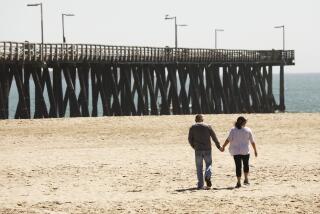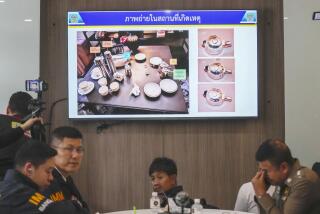Poison Fumes in Tokyo Subway Kill 6, Hurt 900 : Japan: Substance believed to be nerve gas overwhelms passengers. Attack by more than one person suspected.
- Share via
TOKYO — Mysterious poison fumes overwhelmed rush-hour subway commuters today, killing at least six people, sending more than 900 to hospitals and paralyzing the city’s sprawling transportation system.
Tokyo police believe the poison was sarin, a nerve gas first developed by the Nazis in the 1930s that is 25 times more toxic than cyanide. Officials suspect the poison was planted in a deliberate attack by more than one person; traces of it were found leaking from containers wrapped in newspapers on several subway cars.
No suspects have been arrested, however.
Police received emergency calls from 16 subway stations on two major lines beginning just after 8 a.m. from Tsukiji, site of Tokyo’s largest fish market. Passengers reported that a man in his 30s or 40s placed a lunch box wrapped in a newspaper on an overhead rack inside a subway car, then got off.
Shortly after, more than 200 passengers riding the Hibiya Line began coughing and complaining of headaches, diminished vision and nausea. Several collapsed onto the floor and some blacked out, according to eyewitness accounts.
“My eyesight became faint and the surroundings became darker and darker,” one station worker told Japanese television. “All the passengers started making a big commotion and began falling on the floor.”
“I asked one man if he was OK and he said, ‘I can’t stand up.’ Then he began to look pale,” an office worker said.
Passengers inside the subway cars and on the waiting platforms began falling to the ground, some of them knocked unconscious. Others began bleeding from the nose; nearly all reported severe coughing and faltering vision.
Japanese news broadcasts showed morning commuters collapsed on sidewalks, their faces contorted in pain as they loosened their neckties and mopped sweat from their brows. Rescue workers administered CPR to prostrate passengers.
At least 10 people were reported unconscious and listed in critical condition, as emergency workers scrambled to transport hundreds of passengers to 80 hospitals throughout Tokyo. Firefighters, subway workers and even uninjured passengers all pitched in to haul stricken victims up the subway stairs on stretchers and makeshift slings.
Japanese TV showed scenes of chaos at nearby hospitals. Medical personnel administered oxygen and injections to hundreds of victims sprawled out on chairs and floors of emergency rooms, while one ambulance after another pulled up and unloaded more victims.
It normally takes several weeks to completely recover from miosis, a contraction of the pupils that is a characteristic of organic phosphorus compound gases such as sarin. Victims may suffer aftereffects such as breathing difficulties and disorders of the nervous system, specialists say.
“Such actions against innocent people are completely detestable and an indiscriminate murder, an atrocity,” Chief Cabinet Secretary Kozo Igarashi told a news conference.
Kyodo News Service reported that a bottle wrapped in newspapers cracked inside a subway car as the train pulled into the Tsukiji station, leaking toxic fumes. Japanese TV quoted subway workers at other stations as saying they discovered similar packages or puddles of toxic liquid in the trains. At Asagaya station, one worker became ill after trying to mop up some spilled liquid in one car; four employees eventually were sent to hospitals.
Authorities were warning passengers not to touch any unattended packages on any subway or train lines.
The Hibiya subway line, which courses through the nation’s government nerve center of Kasumigaseki, remained closed. Parts of the Marunouchi Line, which passes the Parliament at the Kokkaigijidomae station, and the Chiyoda Line were also closed, paralyzing the nation’s transportation system.
Police originally identified the toxic material as acetonitrile, a colorless liquid used in the synthesis of organic materials. But suspicion is growing that the poison was actually sarin, a gas that cripples the nervous system and paralyzes breathing and cardiac functions. The injection of a minuscule amount can kill a person in 30 minutes.
The gas was developed in Germany in the 1930s but was believed to have been used for the first time by Iraq in 1988 to suppress Kurdish rebels.
The subway incident today is the latest in a series of poison gas attacks in Japan over the last nine months. Last June, sarin was mysteriously released in Matsumoto city in Nagano prefecture (state) northwest of Tokyo, killing seven and sending 161 people to hospitals for medical treatment.
Yamagata prefecture reported a sarin attack in July, and a similar poisoning by an unknown substance occurred this month on the Keihin Kyuko Line headed from Yokohama to Tokyo. Police said they are investigating whether today’s incident was related.
More to Read
Sign up for Essential California
The most important California stories and recommendations in your inbox every morning.
You may occasionally receive promotional content from the Los Angeles Times.














